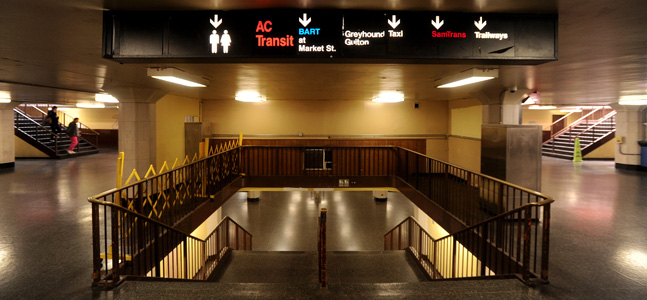San Francisco’s Transbay Terminal is going, going… gone. In the next few months, the gray concrete monolith that has dominated Mission Street between Fremont and First streets since 1939 will become a pile of rubble.

Photo by Noah Berger
Turning Out the Lights at the Old Transbay Terminal
By Marjorie Blackwell
Published: September, 2010
Although the Transbay Terminal has been a bus station for the past 51 years, it was designed and built as a railway station. Designed by prominent architect Timothy Pflueger, it was an adjunct to the San Francisco-Oakland Bay Bridge, serving passenger trains that traversed the Bay Bridge to East Bay cities, Sacramento and beyond. Beginning in 1939, three rail systems carried passengers from the Terminal across the Bay Bridge: the Interurban Electric Railway, the Sacramento Northern and the Key System. The Key System long outlived the other two, shuttling thousands of daily commuters across the Bridge for the next 19 years. The electric trains, powered by a third rail, ran on the lower deck of the Bridge, alongside trucks, while automobiles crossed in both directions on the upper deck. During rush hour, 10-car trains arrived at the Terminal every two minutes for a 30-minute — or less — trip to East Bay destinations in Oakland, Alameda, Piedmont and other East Bay cities. The Terminal, which was financed by 50-cent Bay Bridge tolls, was designed to handle up to 35 million people a year. At its peak, however, it was used by only 26 million passengers a year. Ridership began to decline after the end of World War II when gas rationing was discontinued, and more people began to buy automobiles. By the early 1950s, train ridership was down to 5 million a year. In 1958, the train tracks on the bridge were dismantled, and the bridge was given over entirely to vehicle and bus traffic. In 1959, AC Transit took over the Key System routes, and, although the Terminal continued to be part of the Bay Bridge and was owned and managed by the state of California, it was converted into a bus station, primarily for AC Transit’s transbay buses.
Remnants of the Terminal’s railroad heydays lasted for years, until the 1989 Loma Prieta earthquake damaged the building, and Caltrans boarded up and walled off many of the old sections. One railroad component continued in use until the Terminal closed this summer, however: The elevated loop that AC Transit buses used to drop off and pick up passengers was the same one used by trains.
Shortly before the Terminal was closed for good, Caltrans gave the once vibrant building a last hurrah by opening up some of the old boarded up spaces. On July 30, the public had a chance to glimpse the terminal’s past and see some of the building’s original features, including the large waiting room with curved wooden benches, a 1930s-era diner with green plastic seats and curved counters, a onetime popular bar, a state police office with an adjoining jail cell, a shoeshine stand, a news stand and a long spiral staircase to an underground parking garage.
The Transbay Joint Powers Authority (TJPA), which is building the new Transbay Transit Center on the old Terminal site, is collecting positive memories about the Transbay Terminal and its place in San Francisco’s history. You can share your memories by emailing memories@transbaycenter.org. They will be posted on the TJPA website (www.transbaycenter.org) in the coming weeks.

Photo by Noah Berger

Left Photo by Noah Berger, Middle and Right © Tom Paiva Photography

